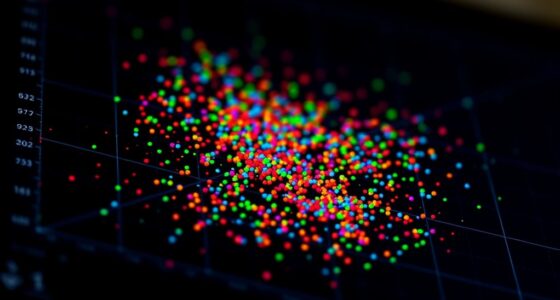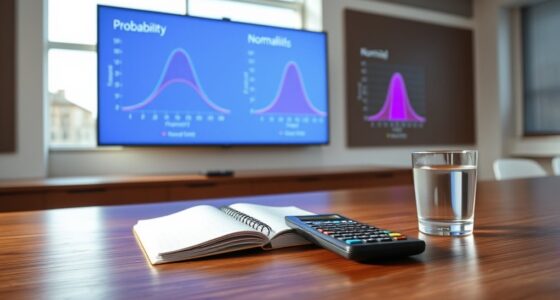Correlation happens when two things move together, but it doesn’t mean one causes the other. Sometimes, a hidden factor, called a confounder, influences both, creating a false link—called a spurious relationship. Causation, on the other hand, means one thing truly causes another. To tell the difference, you need careful analysis, often through experiments or studies. Keep exploring, and you’ll discover how to spot real connections versus misleading ones.
Key Takeaways
- Correlation shows two variables move together but doesn’t prove one causes the other.
- Causation means one factor directly influences the other; correlation alone isn’t enough to confirm this.
- Spurious relationships occur when variables seem linked but are actually influenced by hidden confounding factors.
- Controlled experiments and longitudinal studies are essential to establish true causation.
- Avoid confusing correlation with causation to prevent false conclusions and make better decisions.

Have you ever wondered why two things seem connected? Sometimes, it looks like there’s a link between them, but that connection might be misleading. This is where the idea of correlation versus causation becomes important. Just because two variables move together doesn’t mean one causes the other. It’s easy to assume a cause-and-effect relationship, but often, that’s not the case. Instead, you might be seeing a spurious relationship — a false link that appears real but isn’t. These false connections often happen because of confounding variables, which are hidden factors influencing both variables at play. For example, ice cream sales and drowning incidents might rise simultaneously, but that doesn’t mean eating ice cream causes drownings. Instead, hot weather, a confounding variable, increases both ice cream consumption and swimming activities. Recognizing these confounding variables helps you avoid jumping to false conclusions based solely on correlated data. Additionally, understanding the role of causal relationships helps distinguish true cause-and-effect from mere correlation. The tricky part is that correlation measures how two variables move together, but it doesn’t tell you why they move together. They could be linked because of a causal relationship, or they might just be coincidentally related due to other factors. For instance, studies might show a correlation between shoe size and intelligence, but that doesn’t mean larger shoes make you smarter. Instead, age could be a confounding variable — as kids grow older, their shoe size increases, and they gain more knowledge. That doesn’t mean one causes the other; both are related to age, a confounding factor. To truly understand causation, you need more than just observing correlations. You need controlled experiments or longitudinal studies that can isolate variables and eliminate confounding factors. It’s also important to be cautious about spurious relationships, which can seem convincing but are actually misleading. These relationships often emerge when data is cherry-picked or when a third variable influences both factors without anyone realizing it. For example, a correlation between the number of movies Nicholas Cage stars in and the number of people who drown in swimming pools might be statistically significant, but there’s no real connection. It’s just a coincidence, likely driven by some unseen confounding factor or pure chance. Recognizing these false correlations prevents you from making faulty assumptions or wasting resources chasing non-existent causes.
Frequently Asked Questions
How Can I Identify Causation in Complex Data Sets?
When you’re trying to identify causation in complex data sets, start with clear data visualization to spot patterns and relationships. Then, implement solid experimental design by controlling variables and conducting randomized trials. This approach helps you isolate cause-and-effect relationships rather than mere correlations. By combining visual insights with rigorous experiments, you increase your chances of accurately determining causation in even the most complicated data scenarios.
Are There Statistical Tests to Prove Causation?
Imagine you’re a detective searching for clues; statistical tests are your tools. While they help identify relationships, they can’t definitively prove causation. You need a solid experimental design, controlling variables to test cause-and-effect. Look for statistical significance—small p-values indicating unlikely chance. These tests suggest, but don’t confirm, causation. To truly prove it, you’d conduct carefully designed experiments, not just rely on correlation data.
Can Correlation Ever Imply Causation?
You might wonder if correlation ever implies causation. While a strong correlation suggests a relationship, it doesn’t prove causation due to spurious correlations and lurking variables. To establish causal inference, you need more rigorous evidence, like controlled experiments or longitudinal studies. Remember, correlation can hint at causation, but it’s not definitive without additional analysis to rule out other factors causing the observed link.
What Are Common Pitfalls in Interpreting Data Relationships?
When interpreting data relationships, you should watch out for spurious correlations, which are coincidental and lack real connection, and reverse causality, where the supposed effect actually causes the supposed cause. You might mistake correlation for causation if you don’t carefully analyze the data context. Always consider other factors, avoid jumping to conclusions, and question whether the relationship is genuine or just a coincidence.
How Does Confounding Affect Correlation and Causation?
Imagine you’re watching a puppet show, and confounding variables are like hidden strings pulling different puppets unexpectedly. They can create spurious correlations, making it seem like two things are linked when they’re not. Confounding affects how you interpret correlation and causation because it can mask the true cause-and-effect relationship, leading you to false conclusions. Always look for hidden variables that might be influencing what you see.
Conclusion
Think of correlation and causation like two friends walking together—just because they move in sync doesn’t mean one caused the other to walk. You need to look closer, ask questions, and find the real reason behind the dance. By understanding the difference, you avoid jumping to conclusions like assuming one friend’s steps cause the other’s. Remember, not everything that happens together is connected; sometimes, it’s just a coincidence in the crowd.










